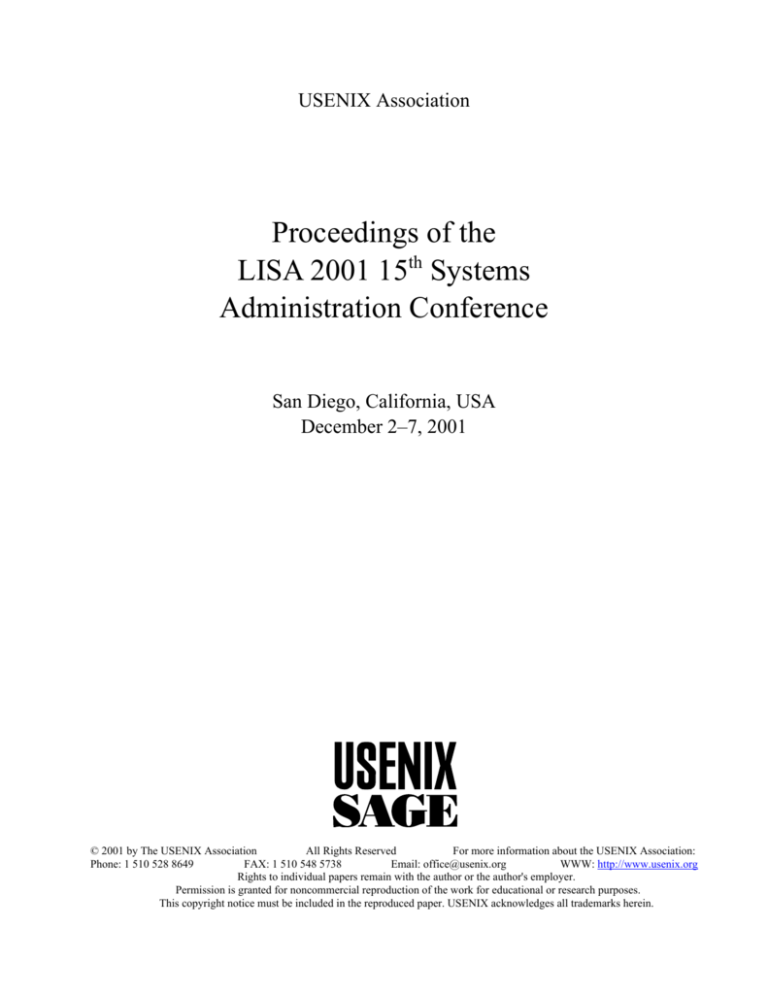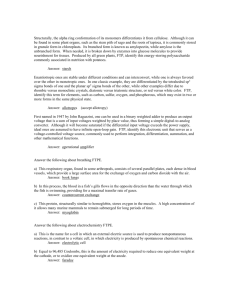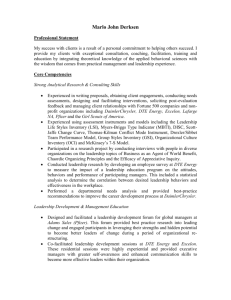
USENIX Association
Proceedings of the
LISA 2001 15th Systems
Administration Conference
San Diego, California, USA
December 2–7, 2001
© 2001 by The USENIX Association
All Rights Reserved
For more information about the USENIX Association:
Phone: 1 510 528 8649
FAX: 1 510 548 5738
Email: office@usenix.org
WWW: http://www.usenix.org
Rights to individual papers remain with the author or the author's employer.
Permission is granted for noncommercial reproduction of the work for educational or research purposes.
This copyright notice must be included in the reproduced paper. USENIX acknowledges all trademarks herein.
Tools to Administer Domain
and Type Enforcement
Serge Hallyn and Phil Kearns – College of William and Mary
ABSTRACT
Domain and Type Enforcement (DTE) is a mechanism that can be effective in providing
extremely fine-grained mandatory access control in complex networked systems. Unfortunately,
this level of control comes at a price: the configuration of a DTE policy is usually in the form of a
dense ASCII file which does not lend itself to an understanding or administration of the policy
itself. We describe a set of graphical tools which aid in that understanding and administration.
Introduction
Precise access control is generally acknowledged
as a means of providing greater system security. The
gross access control of the standard Unix scheme of
twelve protection bits specifying access for the owner
of a binary, the owner’s group, and the rest of the
world has lead to two points of vulnerability in modern Unix systems: the existence of ‘‘set user id’’ (root)
binaries and the root account being exempt from all
access restrictions. Responses to these vulnerabilities
include techniques such as access control lists (LinuxACL [8] is a recent development in access control
lists) and capabilities (such as POSIX capabilities [7]
as partially implemented in the Linux v2.2 kernel).
Each technique attempts to allow finer-grained access
control than the standard Unix mechanism, especially
for processes running with root privilege. For example, using POSIX capabilities, the talkd service may
only need access to restricted network ports, so that it
may be started with only the CAP_NET_BIND_
SERVICE capability. If talkd is later compromised,
the attacker’s privileges on the system are still very
limited, despite being root on the system.
Type Enforcement was introduced by Boebert
and Kain [4] in 1985 as a method of implementing
integrity systems without relying on a trusted user. It
labeled objects as well as subjects, and specified
access from subjects to objects and subjects to subjects in two matrices. Subject labels were called
domains, and object labels were called types. Subjects
to object access could be read, write, and execute.
Type Enforcement was implemented first in the
Secure Ada project (LOCK) [10] , and later by TIS in
Trusted XENIX [1] . Secure Computing still uses TE
in its Sidewinder firewall product [6] .
Domain and Type Enforcement was first presented by O’Brien and Rogers [10] and is an extension
of TE. It differs mainly in specifying policies in an
intuitive policy language rather than using two matrices. Domain-to-domain transitions are allowed by the
execution of special binaries designated as entry
points to the target domain. TIS did the first Unix
implementation of DTE [3] on a BSD system.
2001 LISA XV – December 2-7, 2001 – San Diego, CA
Access control techniques similar to TE and
DTE are a continuing source of research. Most
notably, NSA’s Security-Enhanced Linux project [2]
uses a mechanism much like TE and DTE to control
the access rights for ‘‘process labels’’ (similar to
domains).
The Problem
We have implemented DTE for Linux 2.3 and
2.4. Administering our implementation of DTE consists of editing a plaintext policy file. The system must
be rebooted to effect the changes. The policy file consists of several sections. The first section enumerates
the types and domains. Next are specified the default
type for the file system root (‘‘/’’) and its children, and
the domain in which to run the first process. This is
followed by a detailed definition of each domain. For
each domain, we specify the entry points, permitted
type access, permitted domain transitions, and permitted signals to processes in other domains. The last section lists the type assignment rules. See the sample
policy file in Listing 1.
This policy file should be viewed as part of a
much larger file which defines the DTE policy for a
networked Unix system. It was written primarily to
demonstrate how DTE could defend against root compromise via the recent wu-ftpd exploit [5]. The ftp
daemon provided with Red Hat Linux 6.2 contains a
well-known string format vulnerability that allows any
remote (or local) user to obtain a root shell. This policy file was implemented in a version of Linux 2.3
which had been modified to support DTE [9] and was
shown to eliminate root compromise through the wuftpd vulnerability.1
The policy defined in Listing 1 attempts to confine the access rights of the ftp daemon (/usr/sbin
/in.ftpd) so that a successful overflow exploit against it
does not compromise the rest of the system – certainly, we do not want to allow the attacker to run a
shell with root privileges. Lines 19-21 of the policy
define the ftp_d domain in which the daemon is
required to execute. Note that processes in the ftp_d
1See
the cited paper for details of the syntax.
151
Tools to Administer Domain and Type Enforcement
Hallyn & Kearns
domain may only execute binaries beneath /lib and
/home/ftp/bin, in addition to /usr/sbin/in.ftpd itself.
This follows from the rules
However, the impact of an error in this file may be
disastrous. We address this problem with a tool that
takes the DTE policy file as input and produces a plugin for a Perl/Tk graphical analysis tool.
rxd->lib_t
rxd->ftp_xt
on line 20, together with the type assignments on lines
29, 30, and 34. If there is, in fact, an exploitable overflow in the ftp daemon, our policy will ensure that the
daemon cannot execute a shell, which is assumed not
to reside in a location accessible for execution to
/usr/sbin/in.ftpd .
The ability to use DTE to confine the access
rights of an important process like the ftp daemon, to
which we want to allow relatively easy network
access, clearly limits the damage that can be done if
that daemon is compromised. This power comes at an
obvious price: the DTE policy file is dense, relatively
unstructured, text. In some sense, this is a natural consequence of fine-grained access control. We simply
have a lot to specify when we specify the DTE policy
for a complex system with many domains and types.
01
02
03
04
05
06
07
08
09
10
11
12
13
14
15
16
17
18
19
20
21
22
23
24
25
26
27
28
29
30
31
32
33
34
35
36
37
38
39
Our Solution: DTEedit/DTEview
DTEedit is a DTE policy file editor that understands, and enforces, proper syntax of the policy file.
DTEedit produces a well-formed policy file and (in a
separate file) a representation of the policy expressed
as Perl code. DTEview is a Perl/Tk program that
assists in the administration of DTE. Its representation
of the DTE policy is provided by the Perl plugin output by DTEedit. DTEview internally treats the policy
as a directed graph in which nodes represent types and
domains. An edge from a domain to a type is labeled
to indicate the appropriate access rights; an edge from
a domain to a domain indicates a possible domain
transition through an entry point or, although not relevant in this example, signals allowed from one domain
to another. DTEview takes various closures of the
# ftpd protection policy
types root_t login_t user_t spool_t binary_t lib_t passwd_t shadow_t dev_t \
config_t ftpd_t ftpd_xt w_t
domains root_d login_d user_d ftpd_d
default_d root_d
default_et root_t
default_ut root_t
default_rt root_t
spec_domain root_d (/bin/bash /sbin/init /bin/su) (rwxcd->root_t rwxcd->spool_t \
rwcdx->user_t rwdc->ftpd_t rxd->lib_t rxd->binary_t rwxcd->passwd_t \
rxwcd->shadow_t rwxcd->dev_t rwxcd->config_t rwxcd->w_t) (auto->login_d \
auto->ftpd_d) (0->0)
spec_domain login_d (/bin/login /bin/login.dte) (rxd->root_t rwxcd->spool_t \
rxd->lib_t rxd->binary_t rwxcd->passwd_t rxwcd->shadow_t rwxcd->dev_t \
rxwd->config_t rwxcd->w_t) (exec->root_d exec->user_d) (14->0 17->0)
spec_domain user_d (/bin/bash /bin/tcsh) (rwxcd->user_t rwxd->root_t \
rwxcd->spool_t rxd->lib_t rxd->binary_t rwxcd->passwd_t rxwcd->shadow_t \
rwxcd->dev_t rxd->config_t rwxcd->w_t) (exec->root_d) (14->0 17->0)
spec_domain ftpd_d (/usr/sbin/in.ftpd) (rwcd->ftpd_t rd->user_t rd->root_t \
rxd->lib_t r->passwd_t r->shadow_t rwcd->dev_t rd->config_t rxd->ftpd_xt \
rwcd->w_t d->spool_t) () (14->root_d 17->root_d)
assign -u /home user_t
assign -u /tmp spool_t
assign -u /var spool_t
assign -u /dev dev_t
assign -u /scratch user_t
assign -r /usr/src/linux user_t
assign -u /usr/sbin binary_t
assign -e /usr/sbin/in.ftpd ftpd_xt
assign -r /home/ftp/bin ftpd_xt
assign -e /var/run/ftp.pids-all ftpd_t
assign -r /home/ftp ftpd_t
assign -e /var/log/xferlog ftpd_t
assign -r /lib lib_t
assign -e /etc/passwd passwd_t
assign -e /etc/shadow shadow_t
assign -e /var/log/wtmp w_t
assign -e /var/run/utmp w_t
assign -u /etc config_t
Listing 1: Sample policy file.
152
2001 LISA XV – December 2-7, 2001 – San Diego, CA
Hallyn & Kearns
Tools to Administer Domain and Type Enforcement
graph representation of the policy in response to user
queries. In this paper we restrict the description of
DTEview to those features needed to detect a problem
with the sample policy file listed above, although
clearly the tools will analyze any DTE policy.
We begin by showing a DTEview file type analysis
window in Figure 1. We start a directory traversal at
/home/ftp. This results in a display of the contents of
the /home/ftp directory, which in this case are the bin/
and incoming/ subdirectories. Each element of the display is labeled with its DTE type. By left clicking on
the arrows pointing out of the subdirectory elements,
one may traverse the hierarchy as deeply as needed,
seeing associated types for all file system objects. The
most relevant parts of this display for our purposes are
that:
• the directory subtree rooted at /home/ftp/bin is
of type ftpd_xt, and hence, the ftp daemon can
execute any binary beneath /home/ftp/bin, and
• the /home/ftp directory is of type ftpd_t.
The next DTEview window is the process tree analyzer shown in Figure 2. When invoked, the tool starts
with the domain of /sbin/init and shows the one-step
domain transitions possible by the entry point mechanism. In our example, the top two rows of rectangles
are drawn. Each rectangle represents a process capable
of running in the system, labeled with the domain in
which it runs. Left clicking on a rectangle in the second row will show, in similar form, domains into
which a process represented by the rectangle may
transition through an entry point. No such transitions
are shown in Figure 2. Right clicking on a rectangle
shows the types to which the process/domain has
access rights. The types are represented by the circles
on the third row of Figure 2; this row was obtained by
right clicking on the rectangle associated with the ftp
daemon, and filtering the display to show only types
to which the process has directory write (c) access.
Note that the ftp daemon, running in the ftpd_d
domain, has ‘‘rwcd’’ access rights to any files or directories of type ftpd_t. Clicking on the ftpd_t icon now
brings up the window shown in Figure 3. We see in
the last two lines that ftpd_t is assigned to /home/ftp
and all its children. This is significant because the
directory write access to /home/ftp means that ftpd_d
can rename and replace /home/ftp/bin, under which it
has execute access. If the daemon is susceptible to an
overflow-based exploit, for example, it is possible to
replace the /home/ftp/bin directory with one populated
with Trojan Horse binaries. Since the /home/ftp/bin
directory is intended to contain service binaries, such
as ls, for the ftp daemon, it is easy to imagine a
replacement ls which replies with the contents of
/etc/passwd and /etc/shadow to enable password
cracking off-line. Although this is not as immediately
serious as a root shell, it still represents a substantial
security threat for a real system.
The above problem is an error pattern: if a
domain can change binaries or directories which contain binaries to which the domain has execute access
rights, then processes in that domain cannot have their
Figure 1: File type analyzer window for sample policy.
2001 LISA XV – December 2-7, 2001 – San Diego, CA
153
Tools to Administer Domain and Type Enforcement
Hallyn & Kearns
execution behavior effectively constrained. When
DTEview is started, it runs a check for such a situation
for all domains listed in a control file. If the error pattern is found, a popup window notifies the user. Figure
4 shows the popup window that appears when DTEview is applied to the sample policy.
be just as bad. DTEview can answer the question
‘‘Can a process under domain daemon_d write /bin/sh
within two domain transitions?’’
In order to aid a system administrator in analyzing query results, one can specify labels on domain
transitions. For instance, the security group may have
written a login daemon that uses Java Rings [11] for
authentication, and which they have verified to be correct. They can then label domain transitions out of
login_d, provided it was entered through
/bin/login.javaring, with a string indicating the user’s
identity has been verified by a trusted program. In a
subsequent query as to whether a web server is able to
enter the root_d domain, the security administrator can
ignore domain transition paths which contain such a
transition, as this transition acts as a barrier to any
unauthorized users.
Using these features of DTEview, administrators
can begin to verify specific assertions concerning the
policies which they are writing.
Reachability
Treating the DTE policy as a graph allows us to
make queries concerning access by domains to types
and domains. Restricted to looking at the policy file,
even a simple case such as asking whether a domain
has create access to a directory can become tedious.
The task is complicated significantly when we
consider that a domain may be able to access a file
after performing a domain switch. For instance, a
compromised web server may be allowed to write but
not execute /bin/sh. If it can subsequently switch to a
user domain, for instance, to run a CGI script, and
execute what it wrote from the user domain, this could
Figure 2: Process tree analyzer window for sample policy.
Figure 3: Window showing type assigns for ftpd_t.
Figure 4: Popup window.
154
2001 LISA XV – December 2-7, 2001 – San Diego, CA
Hallyn & Kearns
Tools to Administer Domain and Type Enforcement
Concluding Remarks
Fine-grained access control, as provided by
DTE, has obvious advantages in securing a modern
networked system. It also has the obvious disadvantage of requiring a detailed and lengthy specification
of the access control policy. An obscure text-based
configuration file does not lend itself to understanding
or debugging an access control policy. We have given
an overview (by example) of a technique which models the policy in graph-theoretic form providing a
means for automated analysis and graphical display of
important aspects of the policy. Equally important is
the fact that the model also provides a formal framework within which we can state and prove theorems
about the logic behind the analysis and displays presented by DTEview.
Future Work
DTEedit and DTEview are a good start at easing
security policy administration. Work is also under way
to aid in constructing whole policies from several
coherent pieces (modules), to offer still more intuitive
ways of representing policies for analysis, and to provide more powerful means for proving policy properties. Naturally, this is in parallel to the continued
implementation and maintenance of DTE itself, which
is currently being ported to work with the Linux Security Module [12] project.
Proceedings of the Fifth USENIX UNIX Security
Symposium, June, 1995.
[4] Boebert, W. E. and R. Y. Kain, ‘‘A Practical
Alternative to Hierarchical Integrity Policies,’’
Proceedings of the National Computer Security
Conference, Vol. 8, Num. 18, 1985.
[5] CERT, ‘‘Two Input Validation Problems in ftpd,’’
http://www.cert.org/advisories/CA-2000-13.html,
July, 2000.
[6] Secure Computing, ‘‘Type Enforcement Technology for Access Gateways and VPNs,’’ http://
www.secure-computing.com .
[7] POSIX Security Working Group, POSIX System
API Amendment 1003.1e: Protection, Audit, and
Control Interfaces (withdrawn), October, 1997.
[8] Andreas Grunbacher, http://acl.bestbits.at .
[9] Hallyn, Serge and Phil Kearns, ‘‘Domain and
Type Enforcement for Linux,’’ Proceedings of
the Atlanta Linux Showcase, 4, October, 2000.
[10] O’Brien, R. and C. Rogers, ‘‘Developing Applications on Lock,’’ Proceedings of the National
Computer Security Conference, Vol 14, 147-156,
October, 1991.
[11] Dallas Semiconductor, ‘‘Java-powered Ring,’’
http://www.ibutton.com/store/index.html#jring .
[12] Various, ‘‘Linux Security Module Project,’’ http://
lsm.immunix.org, 2001.
Availability
DTEedit and DTEview are available under http://
www.cs.wm.edu/˜hallyn/dte.
Thanks
The authors wish to thank the the USENIX organization, as well as the anonymous reviewers and
Adam S. Moskowitz for helpful comments.
Author Information
Serge Hallyn <hallyn@cs.wm.edu> is a Ph.D.
candidate at the College of William and Mary, whose
research concerns systems security.
Phil Kearns <kearns@cs.wm.edu> is on the faculty of the Department of Computer Science at the
College of William and Mary. His current research
interests include distributed systems and operating
systems.
References
[1] National Security Agency, ‘‘Evaluated Platforms: Trusted Xenix,’’ http://www.radium.ncsc.
mil/tpep/epl/entries/CSC-EPL-92-001-A.html .
[2] National Security Agency, ‘‘Security-enhanced
Linux,’’ http://www.nsa.gov/selinux , 2000.
[3] Lee Badger, Daniel F. Sterne, David L. Sherman,
Kenneth M. Walker, and Sheila A. Haghighat, ‘‘A
Domain and Type Enforcement Unix Prototype,’’
2001 LISA XV – December 2-7, 2001 – San Diego, CA
155
156
2001 LISA XV – December 2-7, 2001 – San Diego, CA


